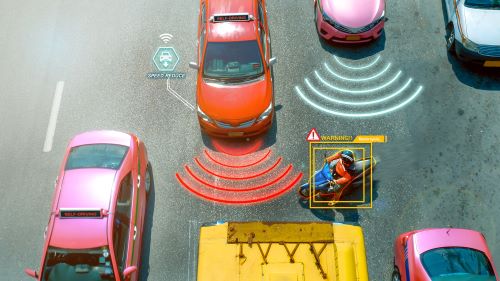
Buying a car is fun and exciting but can also be nerve-wracking and intimidating, especially if you’re new to the process. The current automobile market is flooded with brands from all over the world that make cars of all shapes, sizes, and colors. These entail a variety of amenities and, of course, safety features. Nonetheless, whether you’re looking for a car for you or your family, overall safety should be high on your priority list. Thankfully, most modern models have built-in safety features (in addition to the standard airbags and seatbelts) that allow you to drive with ease.
Key Takeaways:
- While airbags have been a standard safety feature for years, today, they are sophisticated in that they can detect the weight and position of the driver and other occupants, lowering the risk of injury.
- Look for crash-avoidance safety features in your car, including forward collision warnings, automatic emergency braking, lane-keeping assist, and lane-departure warnings.
- Adaptive headlights help enhance night vision by reacting to the speed, elevation, and steering of the car and illuminating the road according to the car’s direction.
Adaptive Headlights
Adaptive headlights are designed to make driving in dimly lit areas, in extreme weather conditions or night driving safer by increasing the driver’s visibility. The beams of the adaptive headlights will rotate upward and downward or sideways to light up the actual path of where you’re driving, whether up a hill or around a curve. And since the beams of the adaptive headlights remain on the road, they don’t directly point at oncoming vehicles; they drastically lower the risk of ultra-bright glares in other motorists’ eyes.
Safety-Belt Features
While seatbelts are undeniably one of the most crucial pieces of safety equipment in a car, enhanced features help seatbelts do their job more efficiently.
- Seatbelt Pretensioners: These will instantly retract the belts to take up the slack during a frontal impact. It helps position you properly to take full advantage of a deploying airbag.
- Force Limiters: A companion feature to pre-tensioners, force limiters will manage the force the shoulder belt builds up on your chest. That means, after the pre-tensioners tighten it, the force limiters let the belt playback out a little to lower the fore.
- Inflatable Safety Belt: Some car models have inflatable safety belts in the rear seat to lower further the force of the belts on rear passengers in an accident. It’s particularly helpful for fragile occupants, such as the elderly and kids.
- Adjustable Upper Anchors: These help position the seatbelt across the chest instead of the neck, preventing neck injuries. They can also help keep the belt from pulling down on a taller person’s shoulder, making it more comfortable.
New Airbag Technology
Airbags have evolved and improved over the years. Today, advanced front airbags have sensors that measure occupants’ seat position, size, and crash severity to determine the inflation levels for the driver and other occupants, which increases safety and reduces injury. Curtain-side airbags are also known to protect all passengers from side collisions that can often lead to serious injuries or worse. Besides, they can lower the chances of ejection during a rollover.
Essential Note: Crash tests by the Insurance Institute for Highway Safety have found that curtain-side airbags are a vital safety feature, but those that protect the head and chest are more effective than those that protect the chest only.
Advanced Crash Avoidance Technologies
NHTSA recommends that buyers purchase cars equipped with three crash avoidance technologies that meet the agency’s performance test requirements:
- Automatic Emergency Braking: This helps prevent crashes or lowers a crash’s severity by applying brakes (imminent crash braking) or helping you in full braking to completely stop (dynamic brake support).
- Forward Collision Warning: This technology alerts you when your car is getting too close to other cars ahead of you, allowing time to steer or brake to avoid a crash. The forward collision warns you if a car in front of you has stopped suddenly or if an undetected car pulls in front of you. Besides, it warns you if you’re going to drive into a fixed object.
- Lane Departure Warning: The warning alerts you if you unintentionally drift out of your lane without a turn signal. That allows you time to steer back into your lane to avoid a collision.
- Side Assist: Side Assist helps you change lanes by using a laser or radar to monitor the traffic in the side lane. That’s especially helpful for monitoring blind spots and lowering accidents from lane changes.
Antilock Brakes (ABS)
Before antilock, it was all too easy to lock up the wheels (stop them from turning) during hard braking. Unfortunately, sliding the front tires makes it impossible to steer, especially on slippery surfaces. Antilock brakes prevent that from happening by using sensors at every wheel and a computer that maximizes braking action at every individual wheel to prevent lock up. It allows you to retain steering control when braking so that you can maneuver the car around an obstacle. Typically, when used, the ABS will have a pulsating sensation conveyed through the brake pedal and chattering at the wheels. If you feel that, it’s the system rapidly applying the brakes to offer maximum power and control.
Need Help Buying a Car in New Rochelle?
While standard safety features are crucial, it’s always wise to look into some modern safety features for a better and safer driving experience. And if you’re ready to buy a car in New Rochelle, visit or call our dealership today. We have a wide array of inventories in our lot, and we’re sure you’ll find something that suits your needs, preferences, and budget!





